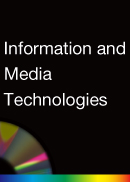Volume 5, Issue 1
Displaying 1-24 of 24 articles from this issue
- |<
- <
- 1
- >
- >|
Hardware and Devices
-
2010 Volume 5 Issue 1 Pages 1-12
Published: 2010
Released on J-STAGE: March 15, 2010
Download PDF (6994K) -
2010 Volume 5 Issue 1 Pages 13-31
Published: 2010
Released on J-STAGE: March 15, 2010
Download PDF (1144K)
Computing
-
2010 Volume 5 Issue 1 Pages 32-39
Published: 2010
Released on J-STAGE: March 15, 2010
Download PDF (240K) -
2010 Volume 5 Issue 1 Pages 40-47
Published: 2010
Released on J-STAGE: March 15, 2010
Download PDF (246K) -
2010 Volume 5 Issue 1 Pages 48-57
Published: 2010
Released on J-STAGE: March 15, 2010
Download PDF (451K) -
2010 Volume 5 Issue 1 Pages 58-76
Published: 2010
Released on J-STAGE: March 15, 2010
Download PDF (350K) -
2010 Volume 5 Issue 1 Pages 77-93
Published: 2010
Released on J-STAGE: March 15, 2010
Download PDF (8237K) -
2010 Volume 5 Issue 1 Pages 94-103
Published: 2010
Released on J-STAGE: March 15, 2010
Download PDF (1022K) -
2010 Volume 5 Issue 1 Pages 104-118
Published: 2010
Released on J-STAGE: March 15, 2010
Download PDF (1459K) -
2010 Volume 5 Issue 1 Pages 119-128
Published: 2010
Released on J-STAGE: March 15, 2010
Download PDF (22125K)
Media (processing) and Interaction
-
2010 Volume 5 Issue 1 Pages 129-138
Published: 2010
Released on J-STAGE: March 15, 2010
Download PDF (27400K) -
2010 Volume 5 Issue 1 Pages 139-152
Published: 2010
Released on J-STAGE: March 15, 2010
Download PDF (5656K) -
2010 Volume 5 Issue 1 Pages 153-163
Published: 2010
Released on J-STAGE: March 15, 2010
Download PDF (1645K) -
2010 Volume 5 Issue 1 Pages 164-176
Published: 2010
Released on J-STAGE: March 15, 2010
Download PDF (3494K) -
2010 Volume 5 Issue 1 Pages 177-183
Published: 2010
Released on J-STAGE: March 15, 2010
Download PDF (827K) -
2010 Volume 5 Issue 1 Pages 184-192
Published: 2010
Released on J-STAGE: March 15, 2010
Download PDF (744K) -
2010 Volume 5 Issue 1 Pages 193-205
Published: 2010
Released on J-STAGE: March 15, 2010
Download PDF (2673K) -
2010 Volume 5 Issue 1 Pages 206-215
Published: 2010
Released on J-STAGE: March 15, 2010
Download PDF (3785K) -
2010 Volume 5 Issue 1 Pages 216-223
Published: 2010
Released on J-STAGE: March 15, 2010
Download PDF (1462K)
Computer Networks and Broadcasting
-
2010 Volume 5 Issue 1 Pages 224-230
Published: 2010
Released on J-STAGE: March 15, 2010
Download PDF (984K) -
2010 Volume 5 Issue 1 Pages 231-242
Published: 2010
Released on J-STAGE: March 15, 2010
Download PDF (1198K) -
2010 Volume 5 Issue 1 Pages 243-257
Published: 2010
Released on J-STAGE: March 15, 2010
Download PDF (2675K)
Information Systems and Applications
-
2010 Volume 5 Issue 1 Pages 258-294
Published: 2010
Released on J-STAGE: March 15, 2010
Download PDF (653K) -
2010 Volume 5 Issue 1 Pages 295-320
Published: 2010
Released on J-STAGE: March 15, 2010
Download PDF (752K)
- |<
- <
- 1
- >
- >|
